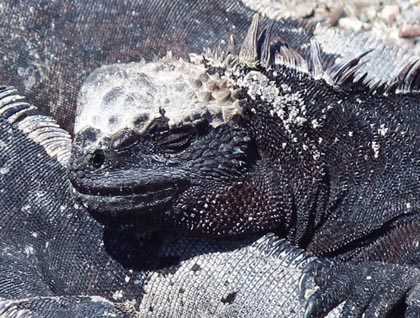After a long nocturnal navigation, the National Geographic Endeavour reached the western side of the Galapagos Islands. Lying next to each other are Fernandina and Isabela Islands, the youngest of the archipelago. The scenery has already dramatically changed since yesterday, with the outline of several shield volcanoes surrounding us. After breakfast we landed at Punta Espinosa, on the northeastern coast of Fernandina. Everywhere we look the landscape is black and inhospitable: large flows of recent basalt cover much of this island. However, life finds its way into newly formed land. After a short while we realize that there are creatures here after all, all of which are rather unique: snakes and lava lizards, Galapagos hawks and herons. But they were all outnumbered by “flows” of endemic marine iguanas, which despite their mean looks are totally defenseless and oblivious to our presence. Some vegetation is present in the area, with red and white mangroves forming little forests, as well as the endemic lava cactus growing in small cracks on the lavas. The circuit around Punta Espinosa brings us to some small groups of flightless cormorants. It is their breeding season right now so we had a unique opportunity to see them courting, dancing and building their nests on the shore. After the walk we returned back to the ship. Next in our schedule was a snorkeling opportunity along the coast nearby. The surrounding waters are shallow and full of nutrients, and this attracts numbers of Pacific green sea turtles to forage on the local seaweed. Our fearless snorkelers were at times accompanied by some flightless cormorants which were hunting the fish or eel.
By midday the sunny weather changed and the sky was covered in clouds. We navigated further north and across the Bolivar Channel which divides Fernandina from Isabela. By 2:00 p.m. we had reached Punta Vicente Roca, on the Isabela coast. We all set off in our Zodiacs accompanied by a naturalist each to explore this amazing landscape, which is the outer slope of a volcano called Ecuador. With its tall cliffs and volcanic features the scenery is fantastic! This area is in the upwelling region so it is also very rich in plankton and fish therefore it holds small populations of both species of sea lions found in the archipelago: the Galapagos and the fur sea lions. For some time, we were surrounded by green sea turtles that simply drifted in the mild current. There were also several active sea bird species either fishing, courting or flying, amongst which we could observe blue-footed and Nazca boobies, brown noddy terns, Galapagos shearwaters and frigatebirds. Once on board, we cruised along the coastline until our ship crossed the equator line, and we all celebrated this unusual event in front of the bridge. A beautiful sunset and a drink in hand to toast for the occasion… what else could we ask for?!







